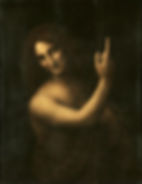Leonardo da Vinci - John the Baptist
- Alexandra Tuschka
- 4. Jan. 2021
- 2 Min. Lesezeit
Aktualisiert: 8. Jan. 2021
by Alexandra Tuschka
It is probably the last of the oil portraits of the great Da Vinci, of which we have preserved a little more than two dozen. John the Baptist is seen - as mostly in the picture - androgynous, young and equipped with his attributes camel hair coat and cross staff. The strong light-darkness is reminiscent of the intimate chiaroscuro of a Caravaggio, but is also due to the patina that has successively settled mildly on the painting over the centuries. This work was in Da Vinci's possession until his death. Does the friendly face represent his pupil Salai? Compared to the Bacchus, it must be noted that at least the same model was available.

On the one hand, the index finger refers to the cross and the suffering of Christ, on the other hand, in the case of this figure, it has become a "pure gesture". The gesture is not only a carrier of content, but also became an attribute of this figure. This is supported by the assumption in research that the fur and wooden staff could be later additions by another painter. The finger was therefore possibly never intended as a reference to the cross by Da Vinci. Thus, as a gesture to heaven, to the invisible, it refers to the higher power outside the painting.
John himself is a frequent companion in the life of Jesus on the picture supports. Above all, he appears in childhood scenes and at the Lamentation of Christ. He is said to have been born about half a year before the latter. His mother Elizabeth is said to be a relative of Mother Mary, but the Bible does not give exact relations. His slightly feral appearance refers to his way of life as an ascetic in the desert, who lived on locusts and wild honey. He preached and referred in his words to the coming of a Messiah. His own fate, however, ended just as tragically - with his beheading.
Leonardo da Vinci - John the Baptist
Oil on wood, 1513-1516, 69 × 57 cm , Musée du Louvre in Paris






